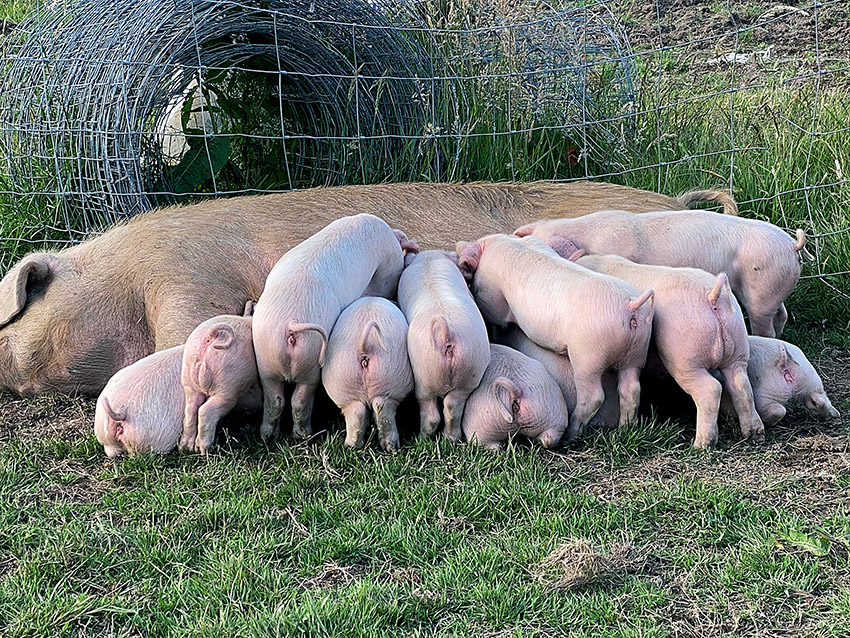
In season 4 of Downton Abbey, Lord Grantham sets off to America reminding Mary on his departure to enjoy her new endeavour – raising pigs. Lady Mary and her beau Charles Blake end up refilling water troughs and getting extremely muddy dressed, of course, all the while in full black tie.
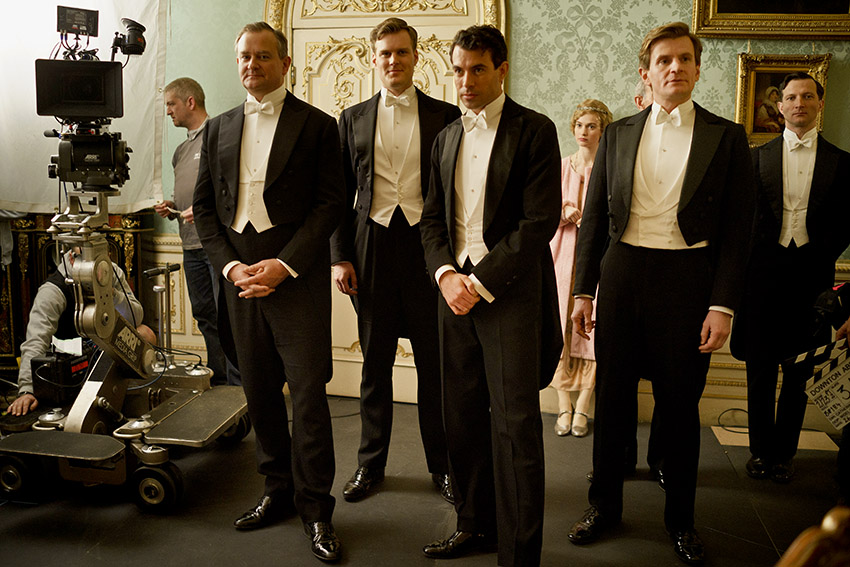
Lots of men in White Tie. So smart ..!
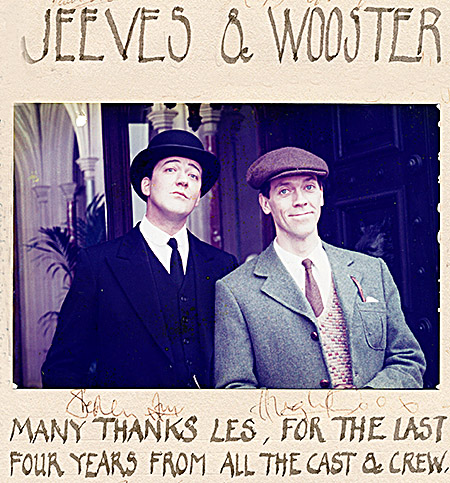 Pigs have starred at Highclere Castle in other fictional roles as well: Highclere was Blandings Castle in the series Jeeves and Wooster with Stephen Fry and Hugh Laurie. One of the main story lines was the competition between Lord Emsworth (who lived here in fiction) and his beloved prize winning sow the Empress of Blandings. His arch-rival Sir Gregory Parsloe owned a sow called The Pride of Matchingham and was always up to dastardly tricks.
Pigs have starred at Highclere Castle in other fictional roles as well: Highclere was Blandings Castle in the series Jeeves and Wooster with Stephen Fry and Hugh Laurie. One of the main story lines was the competition between Lord Emsworth (who lived here in fiction) and his beloved prize winning sow the Empress of Blandings. His arch-rival Sir Gregory Parsloe owned a sow called The Pride of Matchingham and was always up to dastardly tricks.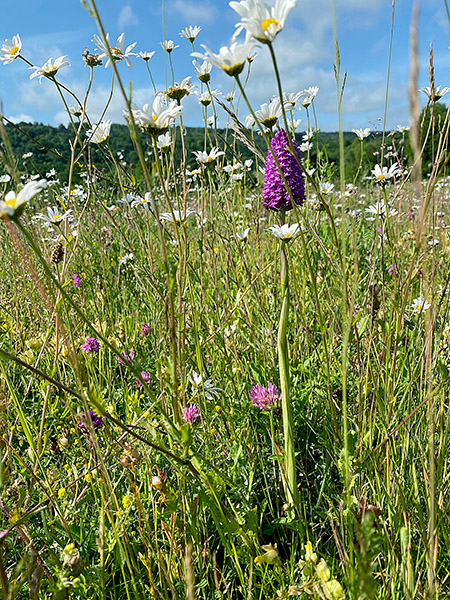
In real life Highclere has raised pigs for centuries and the 4thEarl of Carnarvon and his mother bred award winning pigs 150 years ago. Today Highclere primarily farms wheat, oats, barley and sheep. These agricultural products are essential to what we all eat every day, from flour for bread, cakes and scones, oats for breakfast cereals for us and for horses, barley for beer and malt whiskey and some pearl barley for us. We also grow wildflowers for seeds, leave areas untouched for our fellow wildlife and have areas of permanent pasture. None of this, however, is as cute as animals.
There was a lost area behind some woods and, leaning on gate one day talking to Simon our farm manager, we wondered if the answer was to bring back some pigs and clear the water drain so that they could happily wallow all year round.
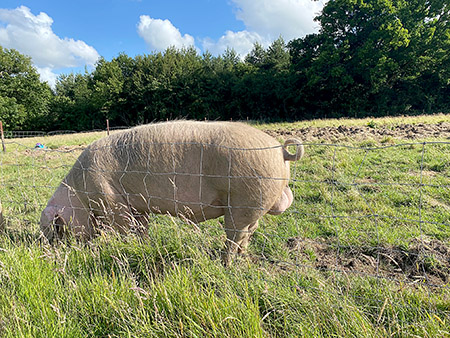
Arthur
This led us to Giles Eustace at Trevaskis Farm in Cornwall and the endangered British Lop. I was aghast and ignorant on learning that there were only just over 100 sows left in the world. Sir David Attenborough has created some extraordinary films which highlight the beauty, the richness of this planet and the extent to which we are leaving no room for wild animals and nature but, in fact, endangered species are not thousands of miles away from any of us. They are right here.
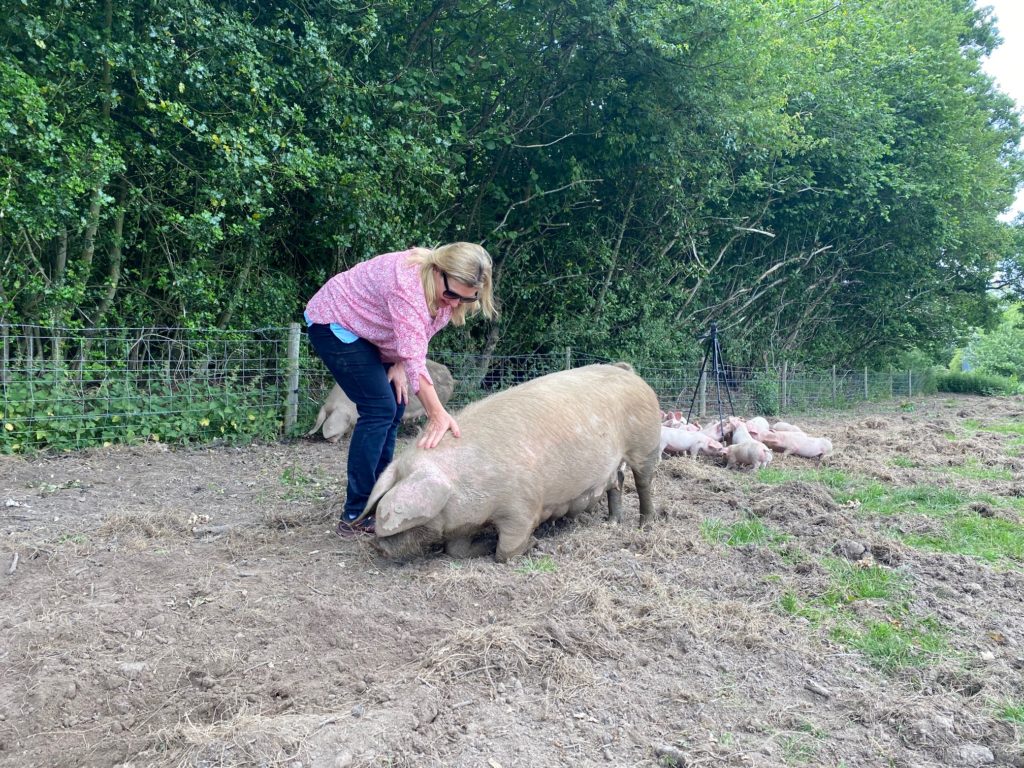
Lady Mary about to sit down in happiness
Beginning with two sows, Thelma and Louise, we rented a boar (Ernie) from Giles at Trevaskis, who suggested that rather than driving a boar up and down from Cornwall, we buy one. Simon and I set off to Trevaskis Farm, near Truro in Cornwall, and returned with Arthur (King Arthur of Tintagel) who successfully mated with our gilts, daughters of Thelma and Louise – Lady Mary, Lady Sibyl and Lady Edith. (They are part of the actress line, Arthur is part of the Cornish line – the gene pools are small).
Two of the ladies are still here. Adam Henson (well known to many UK viewers from Country File) has taken Edith and we have kept Mary and Sibyl. Mary is a rather special person, interested in people, sitting up rather like a dog and loving being patted and scratched – appreciative of the attention and quite relaxed. Sibyl however has her own views on life and Simon and I spent some time trying to get her inside her shed for the night before she farrowed. It is very hard to move a large obdurate pig around.
Each had 9 piglets. In the early days care is needed because if the piglets squeak, their mother is on the case. Now if I pick up a piglet and it squeals, Mary or Sibyl may raise their head but do not run over.
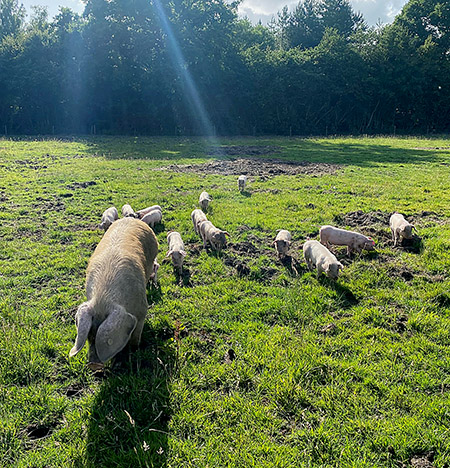 Various commentators pointed out that Downton’s pig theme and plot was not exactly going to create much income for the Grantham family and, similarily, I am not sure my husband took much notice of what I was doing. In fact, he only knew Arthur was coming to Highclere when he came across him in a barn here.
Various commentators pointed out that Downton’s pig theme and plot was not exactly going to create much income for the Grantham family and, similarily, I am not sure my husband took much notice of what I was doing. In fact, he only knew Arthur was coming to Highclere when he came across him in a barn here.
Nevertheless, these rather friendly traditional pigs have now led us to TV and press, with another window into their lives on Channel 5 (June 23rd 8pm) this week. The UK is a leader in good farming practices although it is hard sometimes to demonstrate how well animals are looked after or how balanced the crop rotation practices are. Following 1939, we ploughed up all the land to grow food to survive and continued to try to make sure we were better able to support our food requirements thereafter. In the last fifty years the balance has swung to trying to include the needs of nature as well, learning that the two are often interlinked rather than in competition. Now once again we live in interesting times but small endeavours can take us all towards larger goals. Or, in Lady Mary’s case, not quite so small……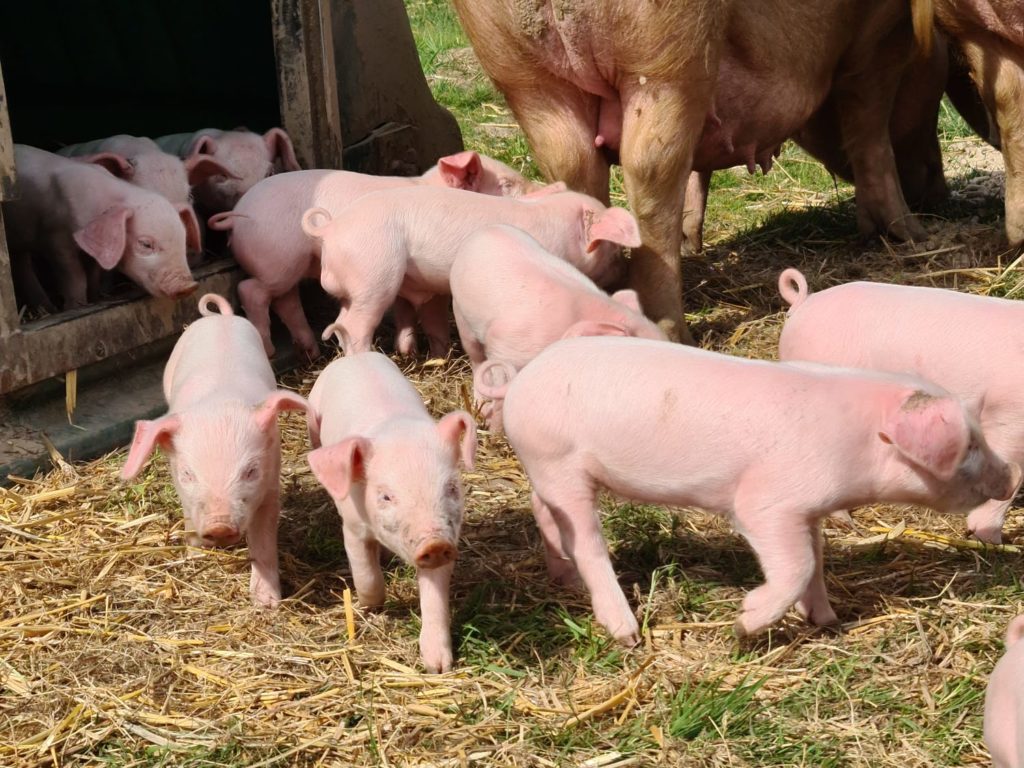








 Instagram
Instagram
How many acres total do you have? My father raised pigs. Nothing as cute as a newborn baby pig and watch it leap for joy daily.
Several thousand yet it is a landscape to share not above all with nature, not for us to trample over… not about consumption but contemplation
I just read your perfect description for our pandemic experience: surreal, a horror story instead of a Cinderella tale. It has been ghastly, hasn’t it, especially for those who feel things deeply. I’m looking forward to the day we can look back and just speak of our “war stories” from this period, instead of being in the midst of living them. Though I am thankful I am still healthy! I love your blogs, having a longing wish that I could express myself with your wonderful gift of writing–so clearly that I can SEE what you are telling!
How kind- the longest day, yet living is very different from being alive..
Dear Lady Carnarvon:
Thank for your Monday blog, and your attempts to protect and propogate a heritage animal.
My personal experience with pigs was through 4-H and the birth to market participation at the annual Wayne County and Michigan State Fair.
I am curious:
1. What was the reaction of the actresses from Downton Abbey who portrayed Lady Edith, Mary, and Sybil to having a farm animal named for their respective character?
2. Does the farm manager live stream on Facebook the day-to-day activities at the Castle’s barn and field?
Look forward to your response.
Until next Monday.
Perpetua Crawford
I would hope that the actors take it all in good humour and affection on our side. The farm manager is very busy and the sharing is through what I share – i am trying to share more!
Merveilleuse histoire de cochon … avant qu’il ne devienne porc. Je le préfère en vie au milieu de ces magnifiques et bucoliques paysages champêtres. C’est un bonheur que de vous lire !
Merci
Dear Lady Carnarvon,
One day I will visit Highclere and hope to have tea with you. Should you like to visit Upstate New York you have a very lovely suite at your disposal complete with view and pool.
Melanie Crawford Loucks
[email protected]
How very kind!
I love reading about your life!!
We live on a tiny farm and have chickens and goats. I believe we hear personally from God through nature. Looking forward to reading your next blog!!
I start to feel nervous and then somehow the next idea arrives!
Hello Lady Carnarvon,
Sadly, we had to cancel our upcoming trip. We will come and see your lovely home though, either next Summer or soon after! I look forward to seeing the beautiful landscape as well as the home. Baby pigs really are so cute, we will take note of all the great livestock when we visit. Thanks for sharing insights of your daily life with us.
Look forward to seeing you – I am busy curating 15 new events and tours in the next year and a half – experiences, laughter and memories I hope there will be something you might enjoy
I am watching Downtown Abbey as I type this! My trip to England was cancelled due to COVID19, and my planned trip to Highclere. My husband and I are planning the new vacation next year.
See you next year! What a surreal time… it is like a horror film and I like Cinderella films!
Ditto in New Hampshire….your entire private suite awaits!!!!
I LOVE this and how you are always up for preserving the past for the future. Kudos to you and Highclere! (BTW, LOVE the “ladies’ ” names!) ♥️ ♥️
Fascinating story and very interesting to hear how these endangered pigs have arrived at Highclere! As an aside I am always very impressed by your wonderful fluency in the English language
Thank you !
I stumbled across your fascinating blog a month ago and have enjoyed learning about Highclere. They bring joy to my Mondays.
I have watched only a few episodes of “Downton Abbey,” and had no idea of the backstory. Thank you for piquing my interest; I plan to watch a few episodes this week. If I stream from the beginning it will keep me occupied for a long time!
Thank you for enriching my world.
They won’t make you rich, but you’ll be amused and well fed. And they’re good for the land.
Happy Summer!
Agreed!
This is brilliant story I love it , reminds me of Debo Devonshire and her interest in farming
She was an amazing woman
How awesome. You are truly blessed. One day I hope to come and visit!
Speaking of visiting Highclere, when do you expect the Castle tours to resume? I have two tickets for August 20. Will you be open then? If not, is there a refund available? I’ll be coming from the US. I hope to!
We are opening in a week or so! Quite a lot of our team are back and we are flat out – it’s good, a good feeling
Once a week, your blog arrives in my “in box” and it is always the brightest spot in my day. Thank you for doing what you’re doing and keep your blogs and podcasts coming ❤️
Thank you – I am glad you like them, I am going to put a link from here, the blog site to the podcast links this week and I thought every Thursday was a good day to publish a new one!
Thank you Lady Carnarvon a delightful read before the fire this evening. Life during Covid 19 is very challenging but there are silver linings, having uninterrupted reading and knitting time is one of them.
Heather Mills, Marysville, Vic
I love your efforts to bring the pigs back to Highclere! I wish I could see the TV program here in the U.S. You did a most appropriate job naming your pigs too! Love the names! I will always cherish my visit to Highclere castle last August! Happy pig farming to you!
Dear Lady Carnarvon,
the piglets are so cute. I couldn’t farm animals as I am too soft, we had chickens for a few years and didn’t eat roast chicken for a good few years after as it was like eating a pet! The eggs however were a godsend with teenagers in the house, scrambled eggs the morning after a party made us the most popular parents ever! Did you manage to name 18 piglets? Jeeves and Wooster were amazing, especially the episode with the cow creamer, when we visited Highclere and walked through the gate by the ticket office, I said to my husband this is the spot where Jeeves revealed the cow creamer cunningly disguised on the car bonnet as a mascot. Happy days!
I am a huge fan of Jeeves and Wooster!
Lieve lady carnavon, ik ben een paar keer op High Clear geweest, heb ontzettend genoten destijds, van varkens heb ik toen niets van gezien. Wel is u te prijzen wat u voor de varkens heeft gedaan. Het hart zit op de goede plek. Nog mooier vind ik de verbintenis met de namen die ze hebben gekregen. Ben een trouwe kijker van Dowton Abby.
Thank you
If I could go back 40 years and do it over again I would be a animal farmer. These “about to be lost” breeds fascinate me. Each was raised for specific reasons whether it be meat, wool, or ability to thrive in certain regions. It is a shame that most people have lost the connection to the land. I always have a vegetable patch and get my eggs from a neighbor. I currently live where no farm animals are allowed, or I would have my own chickens.
Your posts give me a sense of place and of history and are so beautifully written. Thank you for sharing your world with us. Someday I will get to England to see your home.
How I love the lop ears! I once owned a thoroughbred with lop ears and thought he looked as if he was forever wearing a sun visor. He was full of personality, as I’m sure your pigs are as well. Good luck with them and thank you for helping to preserve this historic breed.
Roberta
Growing up on a working farm. Mom sold fryers…eggs…. we had cows and hogs. I had a big white sow run me right up an apple tree. I really thought she was going to climb the tree after me. Yes…she had little ones . Then we had a huge hog that would bust out. Very mean animal. We would scatter while dad would get the beast contained. I’m a city person now, but would take cows anyway over porcine. I look forward to your blogs..thank you. I feel as one of brits. I’m 81+% British.
Has there been any feedback from Lord Julian Fellowes or the actresses in Downton Abbey with the naming of your 2nd litter of pigs?
It has been in the press –
Terrific news about the pigs! While they may not bring in much income, you are saving this breed from extinction. You might consider selling them around England and anywhere else that they might thrive. The more the merrier when it comes to saving them from being wiped off the face of the earth forever…such a valuable endeavor. As your animals grow in number, maybe you need a herding dog named Carson?!
While I don’t have any sows, I have saved a deer and four sets of her twins…her name is Peaches…her favorite meal. She runs across a meadow when I call her and if I’d let her, she’d sit in my lap while I feed her breakfast. It’s so amazing to have this kind of relationship with a wild animal.
Thank you for such an uplifting glimpse into life at Highclere…it will make me smile all week!
Linda Thompson
San Francisco
Thank you for the great read. A certain break from watching the news! I also will admire my photos from Highclere and tea to relive far better times. Be well.
Truest enjoy your blog. Pigs are amazing animals, very smart also. They are good for the land and good for humans to learn more about the creatures we share our time with.
I do have a question. Where does the name Carnarvon come from?
It was from an earlier family and perhaps references Wales
What a fun story to brighten my day. We all need this kind of feel good narrative at this time. Thank you for all you do for the animals.
Thank God it’s Monday and your blog makes my week. So much info. Thank you
Jenny
I am glad
Good morning Lady Carnarvon,
What a fun read that was – thank you! I have, to my great joy, visited Highclere Castle and chatted with you. But I have never (in my 66 years) seen a live pig. After reading today’s blog, I know it is something I must add to my bucket list. Thank you for this terrific essay!
Joan Lerch
Webster Groves, Missouri
USA
I love that you chose Downton Abbey names for some of your pigs. Highclere and Downton live on together in your animals. Wonderful!
Jean Wort, Hudson Valley, NY
Dear Lady Carnarvon,
How genuinely interesting. You might enjoy/profit from googling and looking into Ayshire Farms in Loudon County, Virginia. It was started by (and, I think, is still owned by) the redoubtable & fiercely intrepid Sandy Lerner (yes, the American woman who co-founded CISCO Systems and later bought&restored Chawton Great House as a center for Jane Austen and Feminist Literary Studies….the lady stays BUSY).
In any case, Ayrshire is a model heritage-breeds farm (albeit an enterprisingly large “farm” with a markedly large mansion at its center).
You also might enjoy looking into the American Livestock Conservancy, whose mission is the preservation of many endangered breeds…..cattle, poultry, pigs…..you name it. The head of the organization is my mild-mannered neighbor, Eric Hallman. Just go a-googling.
It’s good, of course, to hear of your conservation efforts/program at Highclere.
Now, if we could only do something to comfort my aging, dog-snob (an accusation to which they readily admit, and are even proud of) friends in Charlottesville. For at least twenty years, they’ve been continually bemoaning the rapid decrease in newborn, purebred Sealyhams. As I recall, a few of theirs, over the years, were imported from England. The decrease appears to be markedly logarithmic, and they’re not provided with any comfort by being told that, just perhaps, scarcely anyone is breeding sealyhams these days because very few folks want a dog that doesn’t do much, beyond looking fairly grand, but bite guests. The mother (who’s 83) has owned sealyhams her entire life and is not prepared to settle (as I’ve done quite happily for years) for a few west highland terriers. She regards them as being merely decorative and lacking in “spirit” (which, all too obviously, her sealyhams have in abundance; they’ve been savaging guests for decades).
In any case, congratulations on your conservation projects at Highclere. the only addition I’d suggest is a few of the grand Royal Palm turkeys. A friend of mine in South Carolina is currently trying to re-establish them, but she’s learning that coyotes have finally moved even into south Carolina. I told her to take up heritage pigs or cattle.
Best wishes,
David Terry
Quail Roost Farm
Rougemont, NC
USA
What a welcome start to my day!
What will you do with all of these piggies? Continue to breed them?
Blessings,
Allyson in Northern Virginia (but born in CT and grew up in Queens 🙂
And find some new homes!
Lady Carnarvon,
What a neat story this morning. I find it interesting that Adam Hinson took Lady Edith. She was an outstanding liberated female for whose decisions I always applauded. Spirited and determined, she well may breed excellent piglets!
Hoping you have a marvelous English day!
Martha G.
Great story on the other aspect of Highclere’s daily operations with the story of the pigs. Good land management and recognition of balance of nature is the key to preserving land fertility and allowing Nature to preserve its processes. The plan certainly continues to work and Kudos to following through with focus on restoration and productive farming.
Using the pigs to clear out thickets for access to create gardens is such an old practice. It does my heart good to know people continue to rediscover what has worked without poisoning the soil.
I finally used one particular hint from an elderly family member to remove “fire ants” (fierce large ants that can kill a newborn animal). The advice was to locate the various nests, dig deep and bring up a full shovel of soil/ants. Each person then goes to another nest and drops the load of ants/soil into that nest. The war ensues and just as predicted the strategy of “divide and conquer” works. Each group of ants attempts to destroy the other. People who attempt to flood the ants out trigger the survival response; all ants will bring up the eggs and create a moving ball in cooperation. This huge colony floats through the flood and saves many of the ants. We were very fortunate in escaping the night-time flooding. The ants were floating away from us.
Nature finds a way to survive.
Best wishes for the revival of the pig breed. Following for the update on sheep management and keeping them at home while the neighbors’ sheep stay in their pastures.
(You can take the girl out of the agriculture life; can’t take the #ag_life out of the girl)
Sincerely,
Ida
Happy pigs and happy owners.
Dear Lady Carnarvon, I love pigs, so have thoroughly enjoyed this weeks blog, I have a book that tells you all about the rare breeds, and the breeds that are no longer. Enjoy the wonderful weather we are going to have this week.
Best wishes.
Lorraine.xx
I am looking forward to sunshine again – and we are having our last virtual cocktail party at the Temple this Friday with a few surprises – we then open to the public but may return in the Autumn!
Good luck with everything.
Regards Lorraine.xx
Wonderful story about the balance of nature and use of the land to support the upkeep of Highclere. I had no idea that the castle”starred” in another series. I imagine there are many historic treasures we will get to hear about in future blogs. I am curious about the time it takes you to uncover these gems each week.
I have been so lucky as I have written some books and thus I am not starting from scratch!
Thank you for naming your pigs for us to enjoy their famous connections.
I’m quite sure I couldn’t name mine and later enjoy them as tasty treats!
So happy you are preserving, a la Beatrix Potter and her sheep. All to mention her The Tale of Little Pig Robinson!
Dear Lady Carnarvon,
Well done! Love the story and history of the pigs! Great names. I also, want to thank you for making Mondays a fun day to open email!!! Always enjoy your blogs. Hope to visit Highclere next years!!
Have a wonderful week.
Lisa Cosgrove
Bolingbrook IL
Thank you
Lady Carnarvon,
What excellent ‘swine history’, especially that of the British Lop. We have many farming friends and most grow crops of corn and/or soybeans, or raise a variety of cattle, but this is the first ‘Lop’ I’ve had the privilege to see. What a beauty!
Highclere is such a versatile and busy place. We love reading your blogs and looking at the photos from your grounds and home. Those little piglets are adorable! You made my day!
I am glad – it is diverse!
Dear Lady C!
What a wonderful post! I enjoy them weekly, but this one in particular, stands out.
I must ask; are Thelma and Louise still with you? We’ve not seen anything of them lately. You could have a nice sized herd soon. I saw at least eight gilts in the above photo!
I started raising pigs when I was 10 years old. I loved it and would do it again in a heartbeat!
Thank you for your most entertaining stories!
Charles Breitwiser
Waterloo, Illinois
Dear Lady Carnarvon,
Oh my goodness, what a delightful story! And I, too, am a huge fan of Jeeves and Wooster!
My long-ago husband wooed me by reading P.G. Wodehouse stories and acting all of the Jeeves and Wooster parts–hilarious! I watch the “Jeeves and Wooster” television series whenever it re-airs, I enjoy it so much. Just brilliant in every aspect, especially the casting. I had no idea that it was located at Highclere. I will be watching extra closely the next time for familiar sights (and sites), which will add even more to my pleasure, having enjoyed a memorable Christmas dinner there.
Perhaps an Empress of Blandings is in Highclere’s future?
Best wishes,
Wanda
Northern Virginia
I was saying that maybe I should try to show a pig!!!
Dear Lady Carnarvon,
Thank you for the pictures of the cute baby pigs. What a good mama to her babies! So cute!
I so enjoyed my visit to your home. The castle. Want to return for another visit. Would love to have tea there!
Loved my visit there. Want to come again. Have tea maybe!
WOW! Unbelievable that they were endangered – I’m so happy you were able to correct it! Animals bring so much more joy than oats and barley I agree!!! Thanks again for another wonderful morning – I have a tennis friend that I turned on to your blog and we may come and visit you next year!
The person who saved the breed is Giles Eustace in Cornwall
Dear Lady Carnarvon,
Thank you for your post today. I have been wondering about a way to hear the podcasts. I look forward to getting the link.
Hoping you have a great week!
I will sort it and I hope you will then have a fun podcast Library to amuse you!
Always love your backstories, Lady C! Thanks so much for taking the time to write them for all of us to enjoy.
@ MARGARET RILEY June 22, 2020 at 12:58 & @ LADY CARNARVON June 22, 2020 at 1:46 pm
Lovely pictures of piglets, but does not the porcine smell invade the castle?
They are a few miles away – on the farm outside the park. The Castle is surrounded by Gardens
Dear Lady Carnarvon;
This post has been my favorite to date!
As someone that was fortunate enough to have visited Highclere Castle (in 2014), I wish the little piglets would have been around to view. The photos of the little ones are darling!
We, like many posts above, are also in jeopardy of losing our UK vacation this year due to the pandemic. If the 14 day quarantine is lifted and flights resume before the end of July, we still may be able to visit the UK again. In the meantime, keep your lovely blogs coming!
I hope it does lift – I think testing is more practical
Good day Lady Carnarvon
Lovely to hear about your pigs and their names. I think I told you about asking my friends for names for our first 100 lambs we bought after we bought a farm. I am glad to hear that someone else names their animals.
We are now retired and miss our farm every day but life goes on and we now stop the car and watch other peoples lambs, not quite so fulfilling, but it brings back lovely memories.
I had not heard about the Lop breed but I am glad you are doing your bit to keep the breed alive and I am also glad that you diversified and now have a working farm, hopefully which will keep Highclere alive and running.
Have a lovely week and take care
Joy
My father in law took up farming in hand when he returned from the war and my husband farmed with him but has taken some really interesting initiatives with Simon
First of all…congrats on your successful efforts with the pigs AND your first podcast! It was so interesting to hear your impression of Highclere vs. your husbands. Having just read both books on Almina then Catherine and your feeling that you are stewards of Highclere….. What a legacy….
Have a wonderful week!
Thank you and you too Janna
They are so cute, and I bet they all have different personalities!
As always, LOVE your Monday Musings! Truly food for thought, and always poignant and articulate! My friend Sarah and I (HUGE HighClere fans!!!) were JUST speaking of our visit to your home as we sat on the back patio, enjoying our surrounding nature over nibbles and tea. Must say that I noted ‘poor Edith,’ once again — always the odd lass out! Also, have to note that a huge white sow plays a significant role in book six of the Outlander series! Happy musings and thank you for my Monday Morning time with you!
Thank you but on the hand Edith has gone to a new home!
This is a delight to read; I love your pigs and the piglets and that you are rescuing an endangered type of pig. The old farm breeds have a special place in my regard. I love the P.G. Wodehouse books which feature the champion pig, and also the TV show. I didn’t realize it was filmed at Highclere.
Wonderful visit couple years ago to your beautiful home. The pigs are so cut and pink when newborns
Lady Carnarvon, Lady Mary is very busy with her piglets. You must have a bond with Lady Mary. It is wonderful that you are increasing the Lop Eared Pigs. Best Wishes, Cheryl
I eagerly look forward to Mondays and reading your weekly blog and I really enjoyed this week’s comments. I adored the pig’s names – so clever and funny. Your sentence about the balance swinging to include the needs of nature and learning that the two are often interlinked rather than in competition and the pictures of the pigs reminded me of a trip I took to Polyface Farm. It’s a “grass-based” farm deep in the Shenandoah Valley of Virginia. They tell you that all of their pastured livestock and poultry is moved frequently to new “salad bars” which offers landscape healing and nutritional superiority. The owners explain they’re in the earthworm enhancement business, that soil biota is their first priority and they point to lush pasteurs supported by ecstatic copulating earthworms to testify to the healing.
Five of my friends and myself had planned a trip to Highclere this October but the virus got in the way and we had to cancel our trip. We’re now hoping that we’ll be able to come next year and maybe even meet Thelma and Louise and King Arthur of Tintagel.
Lady Carnarvon,
Bravo to you for rescuing the sows. Well done!
Blessings,
Phyllis
It is really Giles – but we can create some notice of it!!
As Mrs. Hughes once said to O’Brian “You have been busy!” What a worthwhile endeavour to save a line close to extinction! Kudos and best wishes!
Lady Carnarvon, How are the projects coming along with the opening of Highclere Castle in July? I hope things are running smoothly for you and your staff. All the best, Cheryl
Not enough hours in the day – What is a weekend?
I enjoy your posts so much. Thank you for sharing!
Loved seeing the lop eared pigs and hearing all about them. I was amazed that you were brave enough to wear white pants and white shoes into the pig sty.